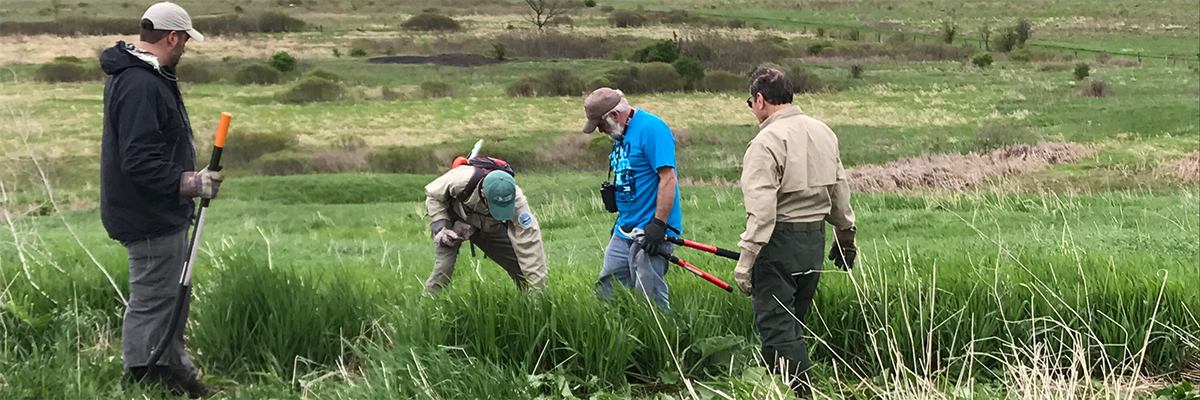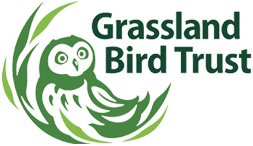These “Best Management Practices” have been developed by wildlife biologists at the New York State Department of Environmental Conservation (DEC), U.S. Fish & Wildlife Service, Audubon and other grassland bird experts. They should be used to guide habitat management on existing grasslands or habitat to be converted into grassland. The goal is to provide and maintain the open, grassy conditions necessary for successful breeding and/or wintering by grassland birds. Activities should be timed to avoid disturbing nesting birds.
Different Birds, Different Requirements
Grassland birds thrive on large, open grasslands as these habitats provide the wide open treeless spaces they need to nest and reproduce. Providing the correct mix of grass height, plant species, and thatch depth benefits the greatest diversity of species. For example, Upland sandpipers, a threatened species in NYS and much of the Northeast U.S., require very short grasses while Henslow’s sparrows require taller vegetation with a mix of forbs. Bobolinks and Savannah Sparrows, two of our more common grassland bird species, have less stringent habitat requirements.
1. Remove or thin hedgerows – this is one of the best actions a landowner can take to improve conditions for grassland birds, as it increases the size of the grasslands. Although trees and shrubs benefit wildlife in other habitats, they generally decrease nesting opportunity and productivity in grasslands, especially when forming thickets or hedgerows. In addition, many of the woody plants that colonize grasslands are aggressive invasive species, such as European buckthorn, multiflora rose, Russian olive, and black locust.
2) Remove woody vegetation within the field – removal and clearing may be done anytime outside the nesting season (April 23 to August 15). If a narrow edge of woody vegetation separates the field from adjacent open habitats, it should be considered within the field boundaries when feasible, and removed. Areas where hedgerows were removed should be periodically cut when woody vegetation starts to re-grow.

3) Mowing – operation of any mechanized equipment or vehicles or other disturbance of grassland birds or their habitat should be prohibited within the field during the grassland bird breeding season (23 April to 15 August) or wintering season (1 November to 1 March) except as necessary to control invasive species.
Where to mow: Large fields should be divided in thirds and one third should be mowed each year to provide a diverse mix of grass heights and densities beneficial to most grassland bird species. For example, for a 300 acre field mow a different 100 acres each year on a 3-year rotation.
If you must enter the fields during nesting season it’s best to drive slowly on designated paths, staying close to tree or shrub lines. Limiting the frequency, speed, and duration of these trips will greatly reduce disturbance to nesting birds.
4) Remove Excess Thatch – thatch, the litter left over after grasses have been mowed, is used by grassland birds to build their nests; a depth of three or four inches is ideal. Thatch also provides cover for voles and moles, thereby benefiting grassland raptors such as the state-endangered Short-eared Owl and the state-threatened Northern Harrier, which survive the winter by preying on these small mammals. Thatch returns nutrients to the soil, but excessive amounts of thatch can smother the growth of new grasses.
5) Management and Removal of invasive or undesirable plant species – initial brush-hogging and cutting of the fields if they have not been under agricultural production will be necessary and favor grasses; some
- European Buckthorn and Bush Honeysuckles – these shrubs should be cut close to the ground and the stump swabbed with glyphosate based herbicide, preferably towards the end of the growing season, late August or early September. Honeysuckles are fairly easy to uproot either by digging with a shovel or pulling up with a chain and winch.
- Wild Parsnip as a biennial, can be controlled by removing the flowers before going to seed in early to mid-July of each year. This can be done by mowing the entire field two to three years in a row which will exhaust the plant and prevent propagation. Caution: the sap of wild parsnip can cause severe skin irritation and extreme photosensitivity in some people. Protective clothing should be worn when working with this plant.
- Bull thistle is also a biennial and can be controlled by cutting before it starts to produce flowers, typically in mid-July of each year, though timing may vary according to field conditions. It should be cut again with the rest of the field, after August 15.
- Canada thistle is a broad-leaf perennial and more difficult to control. If left untreated, it has the capacity to overtake and replace grasses, reducing grassland bird nesting habitat. Once identified, plants should be individually cut after they have grown and have just begun to bloom but before they go to seed- this will likely be in late June- the date should be determined by closely monitoring the infestation. This plant is very difficult to eradicate without herbicides, most of which are labeled as “Restricted” in New York, which means they may only be purchased and applied by a Certified Applicator. Contact DEC Bureau of Wildlife for recommendations.
- Brown knapweed is a broad-leaf invasive member of the genus Centaurea which can interbreed with congeners, making identification more difficult. Chemical control of the Centaurea can be achieved using the same process as for Canada thistle. Without control, this prolific seed producer can rapidly take over a grassland. Chemical treatment has yielded very good results, controlling large infestations for three years or more. There are also a number of biological control insects that feed on Centaurea, albeit overall control effect on the plants is slow and not readily noticeable.
- Staghorn sumac- Although it is native, staghorn sumac can spread clonally reducing available grassland habitat. As individual plants or in small patches it is generally beneficial by providing an excellent food source for birds and mammals as well as an important source of nectar for several butterfly species. As needed, its growth can be controlled by cutting it at the base, chopping and digging up the roots.
